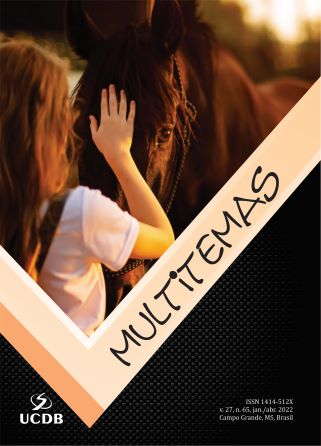Tahiti lime peel flour as an alternative for increasing fiber content in new food products
DOI:
https://doi.org/10.20435/multi.v27i65.3375Keywords:
nutritional composition, sensory acceptability, fruit peel, fruit residueAbstract
The development of new products by adding value to residues such as Tahiti lime peel, which may contribute to additional nutritional value, is of great interest. Thus, this study aimed to characterize the flour of Tahiti lime peel and use it in the preparation of cake, along with the evaluation of its nutritional quality and sensory acceptability. The flour was produced from the Tahiti lime peel, and six cake formulations were made, one standard and the others containing different amounts of this flour (5% to 14%). In addition to the physical and chemical characterization of the flour obtained, cakes with greater sensory acceptability were also analyzed. The Tahiti lime peel flour had high dietary fiber content, 67.70%. All cakes formulations obtained good sensory acceptability, with an acceptability index above 70%. The formulations added to the flour had a higher content of dietary fiber and a lower content of lipid and caloric value in relation to the standard cake formulation. Thus, it can be concluded that there is feasibility of using the Tahiti lime peel flour in the preparation of cakes, adding nutritional value to this product and indicating the potential of the flour to increase fiber content in the diet.
References
Association of Official Analytical Chemists [AOAC]. Official methods of analyses of Association of Analytical Chemist, 16. ed. Gaitherburg: AOAC International, 1997.
Association of Official Analytical Chemist [AOAC]. Official methods of analysis. 16. ed. Gaitherburg: AOAC International, 1990.
BRASIL. Ministério da Saúde. Agência Nacional de Vigilância Sanitária [ANVISA]. Resolução - RDC n. 429, de 8 de outubro de 2020. Dispõe sobre a rotulagem nutricional de alimentos embalados. Brasília, DF: Ministério da Saúde; ANVISA, 2020a.
BRASIL. Ministério da Saúde. Agência Nacional de Vigilância Sanitária [ANVISA]. Instrução Normativa - IN n. 75, de 8 de outubro de 2020. Estabelece os requisitos técnicos para declaração de rotulagem nutricional nos alimentos embalados. Brasília, DF: Ministério da Saúde; ANVISA, 2020b.
BRASIL. Agência Nacional de Vigilância Sanitária [ANVISA]. Resolução-Anvisa nº 263, de 22 de setembro de 2005. Regulamento técnico para produtos de cereais, amidos, farinhas e farelos. Diário Oficial da União: Brasília, DF, de 23 de setembro de 2005.
CRIZEL, T. M.; JABLONSKI, A.; RIOS, A. O.; RECH, R.; FLORES, S. H. Dietary fiber from orange byproducts as a potential fat replacer. Food Science and Technology, London, v. 53, n. 1, p. 9-14, 2013.
DUTCOSKY, S. D. Análise Sensorial de Alimentos. 4. ed. Curitiba: Champagnat, 2013.
MARTÍNEZ-GIRÓN, J.; FIGUEROA-MOLANO, A. M.; ORDÓÑEZ-SANTOS, L. E. Effect of the addition of peach palm (Bactris gasipaes) peel flour on the color and sensory properties of cakes. Food Science and Technology, London, v. 37, n. 3, p. 418-24, 2017
MENDONÇA, L. M. V. L.; CONCEIÇÃO A.; PIEDADE, J.; CARVALHO, V. D.; THEODORO, V. C. Caracterização da composição química e do rendimento dos resíduos industriais do limão Tahiti (Citrus latifólia Tanaka). Ciência e Tecnologia de Alimentos, Campinas, v. 26, n. 4, p. 870-74, 2006.
MONDINI, L.; MONTEIRO, C. Mudanças no Padrão de Alimentação. São Paulo: Hucitec, 1995.
NOOR AZIAH, A. A.; LEE MIN, W.; RAJEEV BHAT. Nutritional and sensory quality evaluation of sponge cake prepared by incorporation of high dietary fiber containing mango (Mangifera indica var. Chokanan) pulp and peel flours. International Journal of Food Sciences and Nutrition, Basingstoke, v. 62, n. 6, p. 559-67, 2011.
OLIVEIRA, R. F.; PRETO, L. T.; SCHMIDT, H. O.; KOMEROSKI, M.; DA SILVA, L. M.; RIOS, A. O. Physicochemical and sensory evaluation of cakes made with passion fruit and orange residues. Journal of Culinary Science & Technology, London, v. 14, n. 2, p. 166-75, 2016.
SANTOS, A. A. O.; SILVA, E. I. V. C.; SANTOS, J. P. A.; SANTANA, D. G.; ALMEIDA, M. L.; MARCELLINI, P. S. Elaboração de biscoito de chocolate com substituição parcial da farinha de trigo por polvilho azedo e farinha de albedo de laranja. Ciência Rural, Santa Maria, v. 41, n. 3, p. 531-36, 2011.
SANTOS, D. S. D.; STORCK, C. R.; FOGAÇA, A. O. Biscoito com adição de farinha de casca de limão. Disciplinarum Scientia. Série: Ciências da Saúde, Santa Maria, v. 15, n. 1, p. 123-35, 2014.
TEIXEIRA, E.; MEINERT, E. M.; BARBERTA, P. A. Análise Sensorial de alimentos. Florianópolis: Editora da UFSC, 1987.
THOMAZ, A. C.; SILVA, G. R.; NOVELLO, D.; DALLA SANTA, H. S.; RAYMUNDO, M. S.; BATISTA, M. G. Aceitabilidade sensorial de biscoito tipo cracker adicionado de farinha de casca de limão siciliano (Citrus limon L. Burm.). Revista do Instituto Adolfo Lutz, São Paulo, v. 71, n. 2, p. 324-30, 2012.
Downloads
Published
How to Cite
Issue
Section
License
Copyright (c) 2022 Multitemas

This work is licensed under a Creative Commons Attribution 4.0 International License.
Os artigos publicados na Revista Multitemas têm acesso aberto (Open Access) sob a licença Creative Commons Attribution, que permite uso, distribuição e reprodução em qualquer meio, sem restrições desde que o trabalho original seja corretamente citado.
Direitos Autorais para artigos publicados nesta revista são do autor, com direitos de primeira publicação para a revista. Em virtude de aparecerem nesta revista de acesso público, os artigos são de uso gratuito, com atribuições próprias, em aplicações educacionais e não-comerciais.


